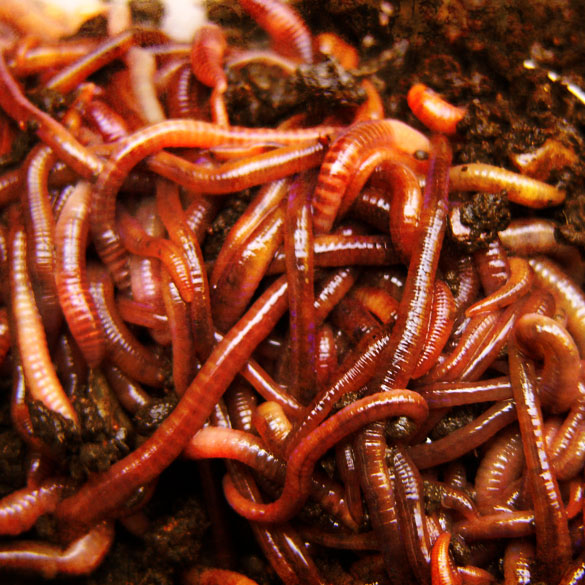Here I am walking to class, bending over in my raincoat and big clunky Wellingtons, trying to balance my umbrella and my massive backpack while picking up a worm. It squirms out of my hands, like it’s trying to evade my rescue, and I feel like a cop who talks a suicidal man down from a bridge.
“Come on,” I whisper, “I can’t let you die out here. You’re gonna get squashed by a bike tire.” The worm contorts into a shape that finally allows me to grasp it, and I feel its slime against my fingers as I toss it into the grass nearby. I always wonder if it hurts to land in the grass after flying through the air, but I comfort myself by saying it’s probably less painful than being stepped on.
Of course, I’ll be the first to admit that I’m saving a species that is technically invasive to the Great Lakes area, according to researchers at the University of Minnesota. And I’m also interrupting a mating ritual – that’s why worms come out onto the sidewalks when it rains. Not because they’re drowning, as most people believe, but because that’s the only time the air is humid enough that they won’t shrivel into worm-raisins when they try to mate. But I figure, which is more likely to result in successful reproduction: copulating on a hard, sandy death trap of bike tires and huge feet, or in the soft, safe grass? I’m doing them a favor, plus giving them a little extra privacy to do their business.
I’ve been a worm-rescuer for at least half my life, but my career in worm-saving really kicked into gear freshman year of high school at a track meet. I was in line for high jump on a damp day, and looking down in horror, I noticed dozens upon dozens of earthworms cast upon the asphalt. Fortunately, they were away from where the jumpers were. But while I waited in line, I discreetly plucked up as many as I could until it was my turn to go. Members of the other teams giggled and whispered behind their hands to each other. But I stood up tall and said, “Fuck ‘em. I’m saving lives out here.”
It’s serious business for me, but I can understand why others find it odd. After all, worms are given a bad rap. They’re immediately associated with death, decay and rotting things. Think of parasitic worms, like tapeworms or heart worms, which can be lethal and quite literally will eat you from the inside out if left untreated. Not surprisingly, worms even have their own phobia—scoleciphobia, from the Greek skolex (which means worm. Thanks, Google Translate!). This fear includes every kind of tubular creepy-crawly, from maggots to earthworms to caterpillars. It’s said to result from a fear of decay, a fear of contamination, or a traumatic event earlier in life involving worms, such as finding an infested carcass or having a worm-related prank played on you.
It does make sense, from a psychological standpoint. Human minds have been trained to avoid things associated with death or disease, lest we contract it ourselves.
This brings back a memory of the kindergarten Halloween party, where my classmates’ moms put together a table of yucky things. Our little five-year-old eyes were blindfolded and our hands were subjected to all sorts of interesting materials. Baby carrots were fingers. Peeled grapes were eyeballs. And a big bowl of cooked, cold spaghetti was worms. My classmates squealed in disgust but I stood there, jaw dropping, wriggling my hands in the pasta. It was the coolest thing I’d ever felt; my teacher had to usher me along in line so the other kids could feel too. I was enthralled, but everyone else was disgusted and I didn’t understand why.
Well, anyway, in addition to a psychological distaste, maybe worms creep us out because they’re so different. According to NatureWatch, a Canadian conservation network, earthworms lack a lung system, respiring through their skin. They’re in the scientific phylum Annelids (along with leeches), which means they’re segmented and they crawl using muscles that encircle their bodies to kind of shove them along, like slimy Slinkies. These muscles are covered in microscopic bristles called setae.
But the weirdness doesn’t stop there. According to the USDA, earthworms can range in size from one inch to two yards. Two yards. Can you imagine finding one of those bad boys in your front lawn? Also, as they slink along, they secrete a cementing agent which hardens the soil and makes it easier to glide through it. NatureWatch said in an article that earthworms are blind, deaf and cannot smell or feel things, so they find their way around using a tongue-like apparatus on their hind end called a prostomium. Some worms can even engage in parthenogenesis (or self-reproduction, for non-scientific folks), but not all of them can, despite what those cutting-a-worm-in-half myths might say. And all earthworms are hermaphrodites, having both male and female sexual organs.
That’s a lot of biology there, I know. But really, can humans get any more different from the common earthworm? Aside from the fact that we’re both in the animal kingdom, we’re fleshy and we occasionally do stupid things like throwing ourselves on sidewalks, we really have nothing in common with our friends, the Annelids. While their talents are indeed unusual, I don’t see the physical differences in worms as scary, but as fascinating.
Another way the worms have been relegated to the “creepy” realm is through the bare bones of the word. In Etymonline, “worm” is from Old English wyrm, which referred to a serpent or dragon – two things many people seemed concerned about back in the day. The word also described a cowardly, weak, pitiful person. Literature provides us with many negative references to our friendly, squirmy, soil-enhancing pal. There’s Jormangund, the worm-serpent child of Loki, in Norse mythology. He is described in particularly dreadful detail in Padraic Colum’s The Children of Odin. Each of Loki’s children had a “greed” that dominated their existence. Jormangund’s greed was “slow destruction.” Well, that’s enough to make Thor decide he doesn’t like the worm, and he casts Jormangund to the depths of the ocean. But he grows larger and larger there, until he eventually is powerful enough to encircle the world in evil. From there, Jormangund gained the snappy title of the Midgard Serpent and was highly feared. We have a more grounded version of the worm in Act 4, Scene 3 of Shakespeare’s Hamlet: “A man may fish with the worm that hath eat of a king, and eat of the fish that hath fed of that worm.” In other words, guess what? We’re all going to die and it really doesn’t matter if you’re rich or poor because we all taste the same to the nasty things that eat us when we’re gone.
So we’re reminded of the humble worm and the dirty work he does, and it almost creates a sense of inferiority in humans. It reminds us that we’re all mortal, whether we like it or not.
But this also shows us how hardworking these little guys are. Unfortunately for them, their work is done underground, out of our sight, where it is less understood. They’re the good Samaritans, the anonymous donors of the animal world, doing their work under cover of darkness. One of the ways earthworms benefit the soil is by burrowing in the dirt. That allows for better water infiltration in the soil. Better infiltration rates mean that plants can access water more easily, and the creation of soil pores prevent the dirt from washing away in heavy rainfall because the water has somewhere to seep in. Earthworms also play a leading role in nutrient cycling, especially nitrogen. According to the USDA, they increase microbial activity in the soil because the dead organics they eat become absolutely laden with microorganisms, which they then release back into the dirt after digestion. And more microbes mean more places for nutrients to cycle around. Worms also help stabilize soil structure (remember that cementing agent they ooze?). And while you don’t need to have worms to have a healthy patch of soil, they are a pretty good sign.
And all this soil-mixing, nutrient-cycling business points to yet another way the worms help us out. Behold:
Vermicomposting.
It is described by Mother Earth News as an “efficient and odorless” way to create a rich, helpful fertilizer for soil. The basic premise of vermicompost is to keep a bin full of dirt. Throw in some fruit and vegetable scraps, leaves, and/or whole wheat products. Add a handful of worms and – presto! They take care of it. When they plow through all the junk you’ve tossed in there, they produce worm castings (read: poop), which contain “100 times as many beneficial bacteria and fungi than what is found in the surrounding soil,” according to Mother Earth News. Worm poop also contains vital elements like calcium, phosphorous, magnesium, potassium and some B vitamins, all of which are good for plants.
And for us.
Tack on another added bonus – water conservation. According to Sharon Lovejoy, author of A Blessing of Toads, “It takes at least eight gallons of water to rinse a pound of kitchen scraps through a garbage disposal.” Worms could plow through that same pound of kitchen scraps in no time, with no water wasted.
Also, I might add from personal experience, vermicomposting is not as gross as it may sound. Upon stepping down the stairs to witness my first bin in a friend’s basement, I was a bit queasy about what it may look like. I pictured a wriggling mass of slimy rotten-food stench, but when we got down there it was anything but. Before me was a bin full of rich, dark dirt—like nothing you’d go dig up out of the ground naturally—and a few busybodies weaving in and out of the clumps of food that remained, slow and dreamlike. Best of all, my nose could not detect anything even mildly unpleasant. It just smelled like dirt, like something that could create life out of detritus.
That’s the miracle of the earthworm, after all.
Earthworms make healthy soil out of dead stuff. Healthy soil grows food. Food aids in human survival (and general happiness). It doesn’t seem that hard. Not to me, anyway. The more worms, the better.
And perhaps the most important reason I save the worms is that I was taught to. That’s just how I was raised. I learned this lesson one rainy night coming back from town with my mom, when I was about eight or so. There was movement in the road up ahead as we crested the last hill before our driveway, which cuts right over a wetland. The road seemed to be squirming. The rain was absolutely torrential, so I thought it might have been the downpour that caused the asphalt to shimmer and wriggle. But as we got closer, my mom gasped and hit the brakes. There were dozens and dozens of frogs and snakes (and probably worms as well) in the middle of the road. Just having a party, hopping and writhing around. We don’t know why they were out there – maybe the rain is mating time for them too – but my mom immediately put the car in park. Right there in the middle of the road.
“We have to save them,” she said, her voice resolute, putting her coat on like a warrior’s armor.
And so we leapt out into the rain and collected or chased as many frogs and snakes from the road as we could. I peered through the downpour, the car’s yellow hazard lights illuminating the night, as I tried to fit more than one frog in my tiny palms before toddling over to the edge of the asphalt to set them in the weeds.
Only when the last frog and snake were cleared from the road did we proceed. My mom ordered me to get in the car as fast as I could, jammed the ignition key forward, and stomped on the gas to get to our driveway before all the creatures inevitably returned to their road-party.
That was the night my impressionable little mind scrawled “reverence for life” in its book of principles. My mom taught me then, that, even if it means being inconvenienced for a few minutes, you do what you can. You go out of your way for the small things that cannot save themselves. Sure, it would have been easier, faster and drier to punch the gas and run over a few frogs and snakes to get to the driveway. Sure, it would be quicker to just walk by a worm on the sidewalk while going to class (plus I’d get fewer stares from people). But you help out, God damn it, if you can. You watch out for the little guys, especially if they plow through dead stuff to help make your food.
So I resume my promenade to class, reminded of why I risk the dirty looks of strangers to save my friends from the sidewalks. Not only do I save them because they’re interesting and benefit me as a human being, but they deserve to be here as much as I do. Some days, when there seem to be hundreds of them tossed on the cement, it’s a labor of love. But I just can’t stand the thought of seeing a little, shriveled worm fruit-roll-up on the sidewalk the next day. So I do what I can. I stand up taller, wiping my friend’s setae-slime on my jeans, satisfied with my good deed. There’s a girl parked on a bench nearby, glaring at me with furrowed brows, wide eyes and an upturned mouth.
I smile at her. I don’t even whip out my hand sanitizer.
—
Mackenzie Myers is a creative writing major at Northern Michigan University. She enjoys a good cup of tea, being in the woods, and is a Capricorn. Her work has appeared in Traverse, Husk, and in an earlier edition of Gadfly Online. When she graduates and transcends her food service career, she hopes to be a publisher and novelist.




Love this piece. Great voice, great exploration:
“I discreetly plucked up as many as I could until it was my turn to go. Members of the other teams giggled and whispered behind their hands to each other. But I stood up tall and said, ‘Fuck ‘em. I’m saving lives out here.’”
Can’t wait to read more!